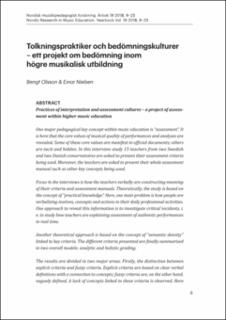| dc.contributor.author | Olsson, Bengt | |
| dc.contributor.author | Nielsen, Einar | |
| dc.date.accessioned | 2020-02-17T13:36:20Z | |
| dc.date.available | 2020-02-17T13:36:20Z | |
| dc.date.issued | 2019 | |
| dc.identifier.citation | I: Nordic Research in Music Education. Yearbook Vol. 19 2018, s. 9-23 | en_US |
| dc.identifier.isbn | 978-82-7853-257-7 (pdf) | |
| dc.identifier.uri | https://hdl.handle.net/11250/2642033 | |
| dc.description.abstract | ABSTRACT -
Practices of interpretation and assessment cultures – a project of assessment within higher music education. -
One major pedagogical key concept within music education is “assessment”. It is here that the core values of musical quality of performances and analyses are revealed. Some of these core values are manifest in official documents; others are tacit and hidden. In this interview study 15 teachers from two Swedish and two Danish conservatoires are asked to present their assessment criteria being used. Moreover, the teachers are asked to present their whole assessment manual such as other key concepts being used.
Focus in the interviews is how the teachers verbally are constructing meaning of their criteria and assessment manuals. Theoretically, the study is based on the concept of “practical knowledge”. Here, one main problem is how people are verbalizing motives, concepts and actions in their daily professional activities. One approach to reveal this information is to investigate critical incidents, i. e. to study how teachers are explaining assessment of authentic performances in real time.
Another theoretical approach is based on the concept of “semantic density” linked to key criteria. The different criteria presented are finally summarised in two overall models: analytic and holistic grading.
The results are divided in two major areas. Firstly, the distinction between explicit criteria and fuzzy criteria. Explicit criteria are based on clear verbal definitions with a connection to concepts; fuzzy criteria are, on the other hand,
vaguely defined. A lack of concepts linked to these criteria is observed. Here the key issue is how the criteria and their functions are verbally explained. The second area concerns the structure of the assessment manual. Is there a tension between different criteria involved in the process or are the different criteria integrated? The latter example shows a higher quality than the first on one.
Since this is an on-going project, further analyses will show the degree of validity and reliability in the project.
Key words: Assessments of musical performances, practical knowledge, explicit criteria, fuzzy criteria, structure of assessment manuals | en_US |
| dc.language.iso | swe | en_US |
| dc.publisher | Norges musikkhøgskole | en_US |
| dc.relation.ispartofseries | Nordisk musikkpedagogisk forskning;Årbok 19 | |
| dc.relation.ispartofseries | NMH-publikasjoner;2018:6 | |
| dc.subject | assessments of musical performances | en_US |
| dc.subject | practical knowledge | en_US |
| dc.subject | explicit criteria | en_US |
| dc.subject | fuzzy criteria | en_US |
| dc.subject | structure of assessment manuals | en_US |
| dc.title | Tolkningspraktiker och bedömningskulturer - ett projekt om bedömning inom högre musikalisk utbildning | en_US |
| dc.title.alternative | Practices of interpretation and assessment cultures – a project of assessment within higher music education | en_US |
| dc.type | Academic chapter | en_US |
| dc.description.version | publishedVersion | en_US |
| dc.subject.nsi | VDP::Humaniora: 000::Musikkvitenskap: 110::Musikkpedagogikk: 114 | en_US |
| dc.source.pagenumber | S. 9-23 | en_US |
